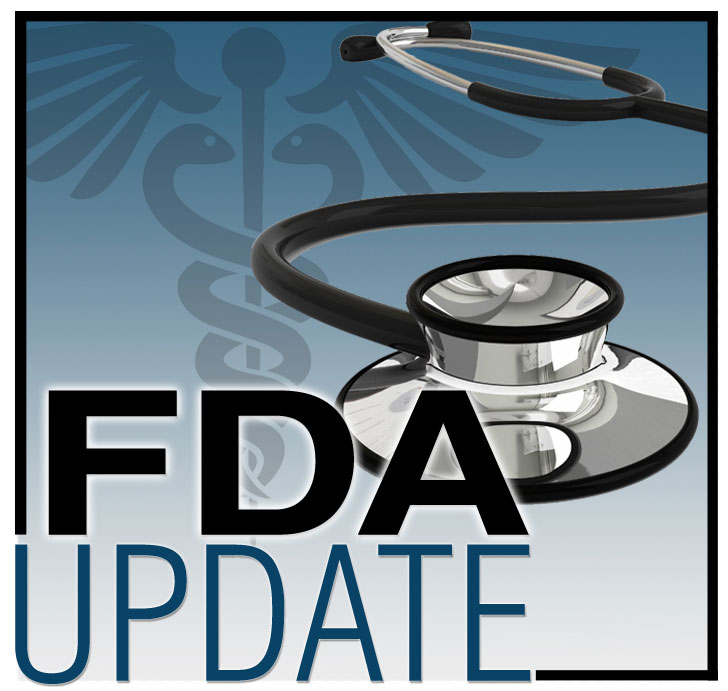FDA Approves ALA Optical Imaging Agent for Gliomas

On June 6, 2017, the U.S. Food and Drug Administration (FDA) approved aminolevulinic acid hydrochloride, known as ALA HCl (Gleolan, NX Development Corp.) as an optical imaging agent indicated in patients with gliomas (suspected World Health Organization Grades III or IV on preoperative imaging) as an adjunct for the visualization of malignant tissue during surgery.
The efficacy of 20 mg/kg ALA was evaluated in three clinical trials involving patients 18 to 75 years old who had a preoperative MRI compatible with high-grade (WHO Grade III or IV) glioma and were undergoing surgical resection. Study 1 included 33 patients with newly diagnosed glioma and Study 2 included 36 patients with recurrent glioma. Both open-label studies compared fluorescence (positive/negative) to tumor status (true/false) using histopathology as the reference standard.
Study 3 was a randomized, multi-center study in 415 patients with a preoperative diagnosis of high-grade glioma by MRI. Patients were randomized to ALA fluorescence arm or to white light control arm. In 349 patients high grade glioma was confirmed by a blinded central read and histopathology. In patients with confirmed high-grade glioma randomized to the ALA fluorescence arm, presence of fluorescence at a biopsy level was compared to tumor status using histopathology as the reference standard.
A total of 297, 370, and 479 biopsies were obtained in Studies 1, 2 and 3, respectively. True positive biopsies (i.e., biopsies that were positive by histopathology and fluorescence) were 178, 342, and 312, respectively. False positive biopsies (i.e., biopsies that were negative by histopathology and positive by fluorescence) were 7, 12, and 7, respectively. True negative biopsies were 27, 3, and 30, respectively. False negative biopsies were 85, 13, and 130, respectively.
The extent of resection among Study 3 patients with confirmed high-grade glioma in the ALA fluorescence arm was compared to that among patients in the control arm, with the “completeness” of resection being determined by a central blinded read of early post-surgical MRI. Percentage of patients who had “completeness” of resection was 64% in the ALA arm and
38% in the control arm, with the difference of 26% (95% CI: 16%, 36%).
The safety of ALA is supported by 5 clinical trials that included 527 patients with glioma. ALA is associated with such risks as phototoxic reactions, hypersensitivity reactions, and interpretation errors (false negatives and false positives). An increase in the extent of resection might increase the risk of serious neurologic deficits in the short term. Adverse reactions that occurred in > 1% of patients in the week following surgery were pyrexia, hypotension, nausea, and vomiting. Adverse reactions occurring in < 1% of patients in the first 6 weeks after surgery were chills, photosensitivity reaction, solar dermatitis, hypotension, abnormal liver function test, and diarrhea. One patient experienced respiratory failure due to drug overdose.
The recommended reconstituted oral dose of ALA HCL solution is 20 mg/kg body weight, administered 3 hours (range 2 to 4 hours) prior to induction of anesthesia. ALA must be used with a standard surgical operating microscope adapted with a blue light emitting light source (power density 40-80 mW/cm2) and ancillary excitation and emission filters to visualize fluorescence excitation in the wavelength of 375 to 440 nm and for observation from 620 to 710 nm. ALA should only be used by neurosurgeons that have completed a training program on use of fluorescence in surgery.
Due to the risk of phototoxic reactions (severe sunburn), do not administer phototoxic drugs such as St. John’s wort, griseofulvin, thiazide diuretics, sulfonylureas, phenothiazines, sulphonamides, quinolones, tetracyclines, and topical preparations containing ALA for 24 hours before and after administration of Gleolan. Reduce exposure to sunlight or room lights for 24 hours postoperatively.
Full prescribing information is available (https://www.accessdata.fda.gov/drugsatfda_docs/label/2017/208630s000lbl.pdf).
Healthcare professionals should report all serious adverse events suspected to be associated with the use of any medicine and device to FDA’s MedWatch Reporting System by completing a form online (http://www.fda.gov/medwatch/report.htm), by faxing (1-800-FDA-0178), or by mailing the postage-paid address form provided online, or by telephone (1-800-FDA-1088).
Follow the Oncology Center of Excellence (OCE) on Twitter @FDAOncology (https://twitter.com/FDAOncology)
Check out recent approvals at the OCE’s new podcast (http://www.fda.gov/OCE), Drug Information Soundcast in Clinical Oncology (D.I.S.C.O.).
In collaboration with the FDA and as a service to our members, ONS provides updates on recent FDA approvals and other important FDA actions (e.g., updated safety information, new prescribing information) pertaining to therapies for patients with cancer. This allows the agency to inform oncologists and professionals in oncology-related fields in a timely manner. Included in the FDA updates is a link to the product label or to other sites for additional relevant clinical information. In supplying this information, ONS does not endorse any product or therapy and does not take any position on the safety or efficacy of the product or therapy described.
